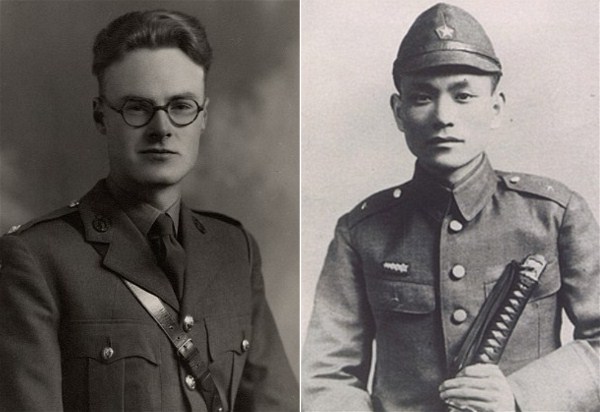PART ONE
NAGASE TAKASHI – A singular Japanese
In the recent feature film The Railway Man the Japanese soldier who tortured Eric Lomax, an English prisoner of war on the Thai-Burma Railway who was caught with a secret radio, is portrayed as a sadistic officer in the Kempeitai, the feared Japanese military police. His real name is used, Nagase Takashi, but the real Nagase whom I met and interviewed in Japan in 1983 has a vastly different story to tell.
********
My meeting with Nagase Takashi arose from a radio documentary series I made for the ABC in the early 1980s on the experiences of Australian prisoners of war of the Japanese in South-east Asia during World War II. The 33 000 Australians who joined the 8th Division AIF and fought their savage but brief actions against the Japanese thought of themselves in the ANZAC tradition, and the thought of surrender had never even been considered.
When the Allied forces surrendered in Singapore in 15 February 1943, the Japanese had to cope with some 15 000 Australians and 35 000 British troops as prisoners of war. The Japanese, whose Bushido code demanded they die rather than surrender, considered the Europeans dishonoured and worthless. Quite quickly they put them to work as slave labour on projects like the Thai-Burma Railway – where one in three Australians died – and building an aerodrome in Sandakan in Borneo, leading to the infamous death marches and the death of some 2000 Australians and 500 British POWs – the single biggest atrocity of the Pacific War.
If the Japanese had been smarter, they would have achieved these projects much more efficiently had they fed their slave workers a bit better, and provided basic medicines and vitamins that were available. But malaria, dysentery, cholera, beri beri and sheer starvation soon took their toll on the Allied troops. The Japanese, and their Korean and Formosan subordinate guards, were indifferent to the needless deaths of their captives in the jungles of Borneo, Thailand and Burma.
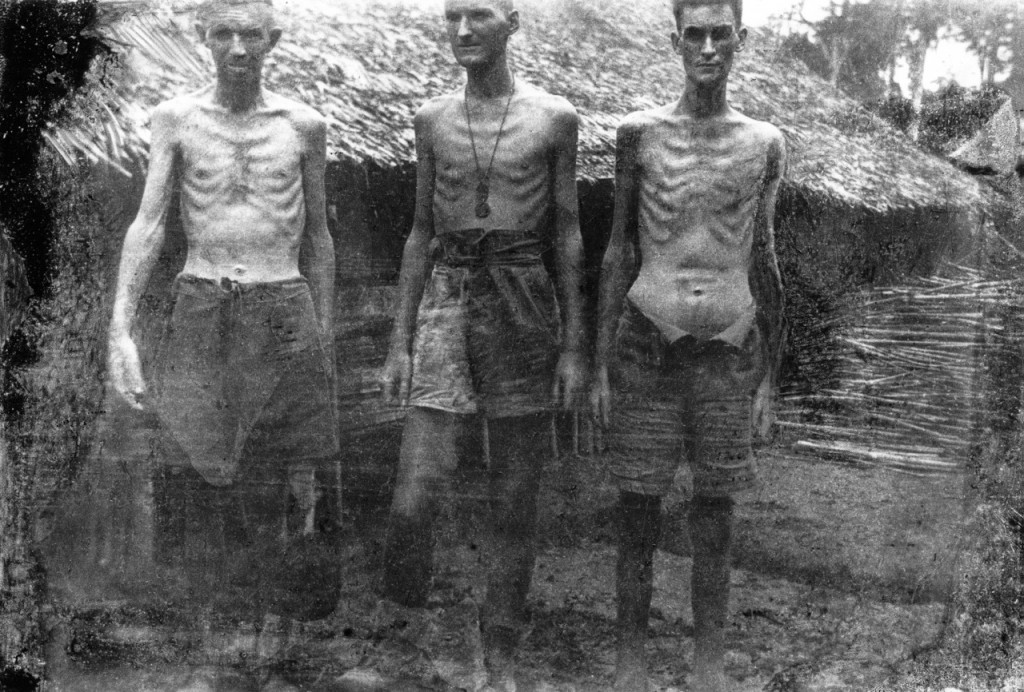
This remarkable photograph taken secretly by Australian Private George Aspinall in northern Thailand during the building of the Thai-Burma Railway shows the skeletal and desperate plight of the so called ‘fit’ Australian workers the Japanese forced to build the railway in 1943. The swollen stomach of the man on the right is caused by ‘wet’ beri beri. (Photo from Changi Photographer)
Fortunately for me, there was no shortage of Australian ex-prisoners of war who were prepared, in the early 1980s, to tell me about their extraordinary experiences, and their stories featured in a 16–part radio documentary series titled Prisoners of War – Australians Under Nippon, first broadcast on ABC Radio in 1984 (although curiously many had not spoken before in detail about their experiences, even to their families). I did not think that there would be any hope of getting any Japanese involved in the construction of the railway, either as guards or engineers, to speak to me. But then I heard about the existence of Nagase Takashi, an English-speaking former interpreter who had worked on the railway, and who had become an apologist for the bestial and frightful way the Japanese had treated their forced labour workers during its construction.
He had actually built a Buddhist temple in Thailand, near the ‘Bridge over the River Quai’ near the town of Kanchanaburi, at his own expense – the starting point for the railway – and made regular pilgrimages there in his crusade to atone and apologise for what the Japanese had done during the war.
Through several ex-POWs that Nagase had befriended, I was able to contact him in Japan and ask if he could speak to me on tape, and also introduce me to other Japanese servicemen who had been involved. I was surprised and delighted when he said he would be pleased to help me, if I would come to Japan.
So began one of the most remarkable experiences of my life. Nagasi Takashi, and his wife Michiko, lived in Kuroshiki City, south of Tokyo not far from Hiroshima – the city destroyed by one of the two atomic bombs that help bring the war to an abrupt end in August 1945.
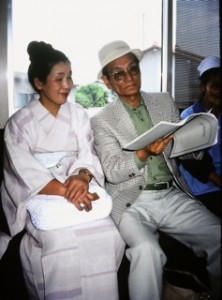
We travelled by train to nearby cities to meet the interviewees. Yasuko came too on some of these occasions. (Photo Tim Bowden)
Travelling on the high speed ‘bullet’ train from Tokyo, I was met by Nagase, a small, gentle, scholarly man in his late sixties, who took me to his house and introduced to me to his wife Yasuko – who happened to be an expert in the art of Japanese tea ceremonies. When I had to endure one Yasuko’s long and intricate affairs (the tea tastes bitter and ghastly by the way, reminiscent of crushed lawn clippings) Nagase later confessed to me that he shared my view that tea ceremonies were as entertaining as watching the grass grow. Having to sit cross-legged (not something Australians do much if at all) during the whole performance was excruciatingly painful as well.
(I should say at this point that at the time I did not know anything about the experiences of British POW Eric Lomax, whose book The Railway Man was not published until 1995.)
Of course the ex-railway veterans I was about to meet where Japanese who had been caught up in circumstances beyond their control, and were unlikely to be interviewed by me had they anything to hide. Indeed many of the Japanese responsible for the worst atrocities had been either hung or gaoled after the Tokyo War Crimes Trials from 1946 – 948 and would not have wanted to see or talk to the likes of me.
My first interview, with Nagase translating, was with a former guard on the Thai-Burma Railway, Shirago Kikuji. Now bedridden and frail, he was keen to tell me that the appalling conditions on the railway had taken its toll on everyone there, but agreed that the prisoners-of-war were shamefully treated.
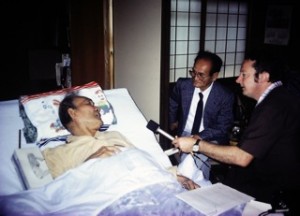
It was good of Shirago Kikuji to talk to me at all, as he was clearly very ill and bed-ridden. (Photo Tim Bowden)
One of the most engaging ex-servicemen I met was Dr Morioka, a wealthy Kyoto dentist, who it transpired had been a kamikaze pilot! So how was he still with us? Dr Morioka explained, through Nagase, that he was being held back for the defence of the homeland. The dropping of the atomic bombs on Hiroshima and Nagasaki meant the war ended quickly, so he did not have to tie on the white headband and fly to his death. Dr Morioka (who had a dry sense of humour) professed to be very grateful to the Americans for dropping the bombs, as they had clearly saved his life!
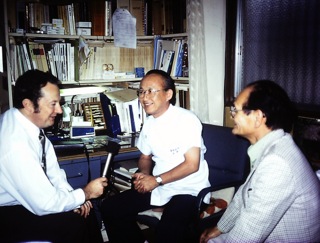
A cheerful Dr Morioka telling me of his good fortune to survive being a kamikaze pilot. (Photo Tim Bowden)
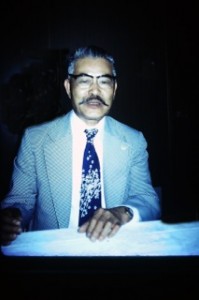
W O Okuyama who still talked like a Sergeant Major, barking his answers seemingly from the pit of his stomach. I didn’t argue with him! (Photo Tim Bowden)
One of the most forceful interviewees was a former Warrant Officer from the Railway Battalion, composed of engineers whose job it was to build the railway. Sergeant Majors are never retiring souls in any army, and he was forthright about how he went about doing a demanding job – although he said he never had direct dealings with the prisoners of war workers himself, a job done by others. He was still very much the sergeant major in his demeanour and attitudes. For him it was just a job that had to be done and was done under extraordinary circumstances, expressing professional pride that it was achieved.
In a traditional Japanese ryoko hotel in Kyoto, I recorded my interview with Nagase Takashi. When the war broke out in December 1941, he was a student in the fourth grade of the Christian College in Tokyo. His frail health meant he was accepted into the ‘Third Degree of the army physical test’. He first volunteered for the navy, but there were no vacancies, so went to the army where a handy bit of nepotism – he had a relative who was a high-ranking officer in the Headquarters of the General Staff – and was enlisted as an interpreter.
His first posting was to Saigon, and then to Singapore in 1942 where he recalled seeing the heads of Chinese and Malays on sticks at the some street corners, with signs identifying them as espionage agents for the Allied forces.
TB: What did you think when you saw things like that?
NT: I thought that such things were done in the Edo Period, two or three hundred years ago. I thought at that time that the Edo period had come back to South-east Asia. I wondered why did the Imperial Japanese Army do things like this? I thought the army must be honourable, and we came to South-East Asia to get rid of the white people. We were told so, and believed so. But the real things I saw were quite different.
Nagase’s association with the Thai Burma Railway began in early 1943 when he was ordered to mingle with the Allied prisoners of war at the Singapore Railway Station, who were being loaded into cattle trucks for their journey north to Thailand. Apart from giving the POWs instructions in English, one of his jobs was to e spy on the Allied soldiers to listen what they were saying, and note the equipment they were taking with them.
Curiously enough he recalls some of the English soldiers carried individual parts of a radio. ‘For instance, one person had the coil, another had a tube [valve] and I asked one of them, “Why do you have this, it is nonsense”? But he said, “It is my mascot [souvenir]”, so we let them go.’
He would have good reason to remember this ‘strange’ behaviour later that year, when to his dismay, he was ordered to be an interpreter for the Japanese military police, the Kempeitai, in Thailand. He had no option. The Kempeitai were an extraordinarily powerful and ruthless organisation. Even a Kempeitai corporal could pull up a senior officer, be he a colonel or even a general and upbraid him for having a button undone on his uniform. They specialised in summary executions, and brutal torture – they were notorious for always getting a confession.
His first job was to mingle with the Allied POWs and listen to their conversations, first to report what they were thinking, and secondly to see if he could uncover any illegal activities.
For some months Nagase was so ill he was sent to Saigon for three months to recuperate. When he got back to Thailand in October 1943, the construction of the railway was almost finished. ‘When I came back to the monkey house [prison] it was full of many prisoners. I had to interpret their interrogations.’
There was one particular prisoner whose torture and interrogation haunted Nagase for the rest of his life. He could not recall his name when we spoke, but he was a British POW, Eric Lomax (later to write about his experiences in his book The Railway Man). In fact he would not meet Lomax until 1995, twelve years after my meeting with Nagase.
Lomax was in real trouble. He had been complicit in assembling the parts Nagase had noticed in Singapore earlier that year, into a working radio, which was discovered in a thorough Kempeitai search of their huts at the work camp in Kanchanaburi. So began a period of beating and violence for all the British soldiers thought to be implicated. Worse still, for Lomax – a life-long railway buff – he had made, for his own interest, a map of the entire route of the railway from its beginning in Bampong in Thailand, to Thanbyuzayat in Burma – a distance of 415 kilometres. Unfortunately, when he realised they were to be taken away from their camp to somewhere else, he took the map from its secure hiding place in a hollow of bamboo in his hut, and concealed it on his body. It was soon discovered, but the discovery of the map, was an added utter disaster for Lomax. Why would he do this? The Kempeitai were convinced Lomax had prepared the map to pass on to the Allied forces already closing in on Burma and Thailand. What other explanation could there be? Nagase understood that the map was most probably done as a hobby. But he was powerless to influence what went on. In a hushed voice, Nagase spoke frankly into my tape recorder:
NT: For instance I can tell you one very brutal interrogation. His hand was already broken, and one leg. He was taken to our desk and then hit by the Kempeitai. If he confessed he had the map for espionage, then he would be sent to Court Martial and maybe killed. He never confessed. So he was taken into the bathroom. It was my terrible experience to see these things.
They put a towel over his nose and mouth. And then the Kempeitai brought a big kettle full of water, and then pour down into his mouth. You know, the towel becomes wet and he can’t breathe by nose. So he opens his mouth, the water comes straight into his stomach. Soon his belly fills up, but when he shuts his mouth, he can’t breathe through his nose. I couldn’t do anything, but I thought I must do something. So I just took his hand, and am afraid he would die. I felt his pulse, and it was going well despite such miserable treatment. And three times a day I nearly fainted, and the military police told me, ‘You are Japanese Imperial Army Interpreter. Be strong!’
Eric Lomax was sent to a Court Martial in Bangkok, and then sentenced to imprisonment in Singapore’s feared Outram Road Gaol, a military prison where solitary confinement in tiny, filthy cells, starvation rations and regular beatings were the order of every day. But he survived until the end of the war.
Meanwhile when the war ended suddenly in August 1945, Nagase had a stroke of luck. He was fearful of being involved with the Kempeitai, and asked and was granted permission to return to his unit at the General Staff in Bangkok just before the victorious Allied forces arrived. The Allies quickly made use of his interpreting skills, and seconded him to the War Graves Commission (with his Japanese colleague I had interviewed by his bedside, Shirago Kikuji) to travel the entire length of the Thai-Burma Railway over 20 days, and record the details of the war graves. It was an experience that changed Nagase’s life. He had absolutely no idea of the scale of the slaughter caused by the building of the railway.
NT: There were over twelve thousand graves, both sides of the railway, so many cemeteries half buried in the jungle. Day and night, I saw so many graves and cemeteries. I don’t know why, but I picked up some flowers by the roadside, and put those flowers on the graves. It gradually came to my mind that this is not the thing that the Japanese Imperial Army should do. That twenty day journey changed my life completely. I never forgot that journey when I came back to Japan.
Then Nagase said something that utterly astonished me, something I never expected to hear a Japanese say, especially as the war time Emperor, Hirohito, was still alive in 1985.
NT: The education which we were given before the war was totally wrong. Because the Japanese leaders thought of themselves, not our common people, and they always think of our Emperor only. So I now hate him very, very much. I want the Emperor system to be abolished at once.
TB: Do you hate the Emperor personally, or the office?
NT: Personally and officially. You know there are still one million and twenty hundred thousand Japanese skeletons, scattered in the islands of the South Pacific and also in South Asia. I think the Emperor must go around the islands and other places to pick up their bones.
TB: But it’s said that the Emperor did not have much to do with the war…
NT: No, never. Without Emperor, any Japanese couldn’t do anything. He was the Almighty. And all Japanese people know he was Emperor at the same time he was a great grand-general of the Japanese army.
TB: Do you think he should be tried as a war criminal?
NT: Yes, No 1 war criminal. I feel very sorry for the Japanese soldiers who committed the very bad things towards the POWs and all the other common people in many places in South-east Asia. They thought they were ordered by the Emperor to do it. The senior officers told us we must obey because of the Emperor’s orders.
********
IF YOU HAVE ANY COMMENT TO MAKE ON THIS ARTICLE OR ON ANY POSTING ON THIS BLOG PLEASE USE THE CONTACT BUTTON UNDER THE HEADER BAR


